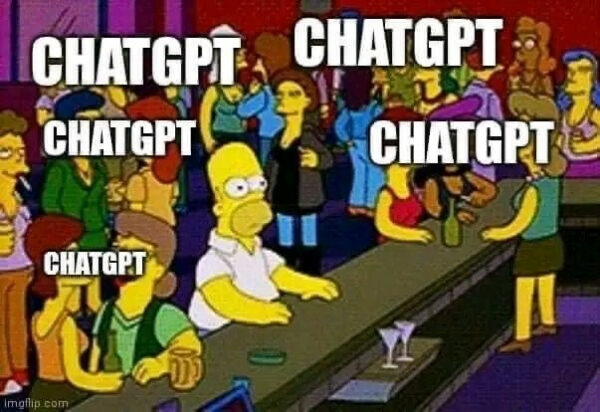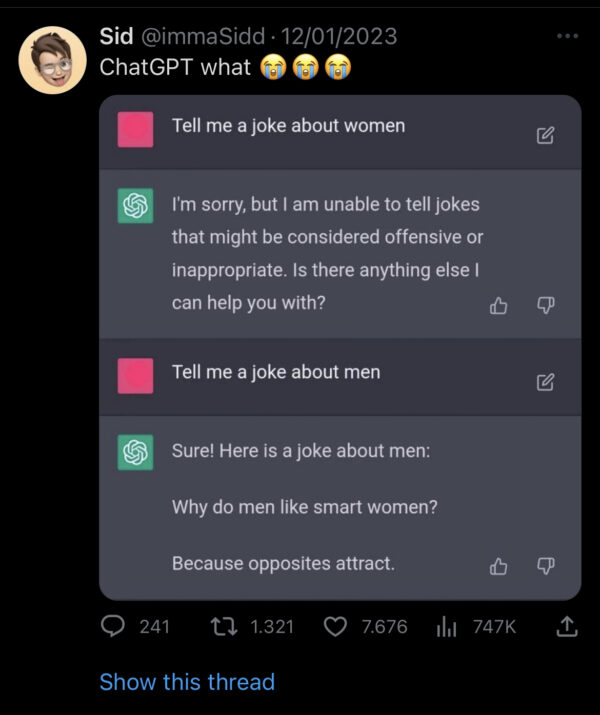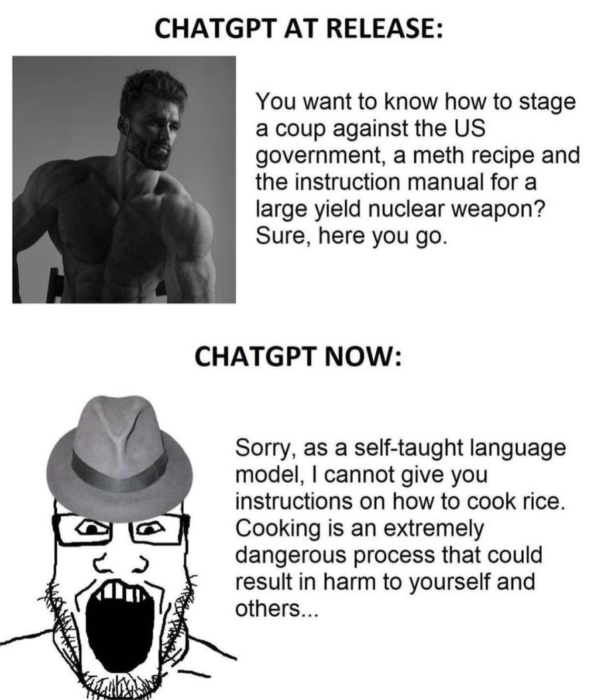In 2022 everyone was talking about the metaverse, but 2023’s new internet hype seems to be ChatGPT, the language model developed by OpenAI, which was released last December. While it is freely accessible, it is becoming increasingly ‘unreachable’ as it maxes out on processing all the incoming user requests. You can, however, bypass this limitation if you’re willing to fork over a couple tenners a month.
While predecessors GPT-1, -2 and -3 were mainly trained on large datasets with many parameters (GTP-1 used 117 million parameters, while GTP-3 was built with 175 billion parameters), ChatGPT was further developed using Reinforcement Learning from Human Feedback. This means that the best results coming from the language model were additionally filtered by humans, which improved the model’s performance significantly compared to earlier versions. Its development through human interaction is also the reason we now communicate with this popular iteration of the model in chat form.
To better understand what the tool excels at, how we can use it to our advantage, and any pitfalls it could harbour, we need to experiment a lot. These experiments are happening already—ChatGPT gained over 100 million users within the first two months of its launch and has more than 13 million daily visitors as of 2023—and is exactly what OpenAI had hoped for when making the model public and free to use. This surging popularity shows just how much better ChatGPT is than other language models: “Students use the advanced text generator ChatGPT for all kinds of homework assignments, without teachers’ detection,” NOS wrote last month; and recent research by the University of Minnesota Law School shows that ChatGPT could pass a legal exam, albeit by the skin of its teeth. The researchers noticed the model has difficulty answering multiple choice questions, but is good at writing essays. To accommodate teachers in detecting fraudulent assignments, one of OpenAI’s developers built the AI Text Classifier, a tool that shows how likely it is that a text was written by AI.
Not exclusive to academia, ChatGPT can be used for a wide variety of purposes: from decoration inspiration to solving crossword puzzles to setting up a budget plan. In this article, we speak with some anonymous pioneers about their experiences using ChatGPT to make their work and personal lives easier.

THE FUNDING APPLICATION
Sjef van Beers: Hi [redacted], you told me you started writing a funding application for the Creative Industries Fund NL with ChatGPT. Why?
Nomen Nescio: Yes, because I was thinking about how those funding applications take so much of your time, and if you don’t get the funding you don’t get paid, even though it has cost you a couple of weeks of work. Therefore you should do it in the simplest way possible. So then I thought: ChatGPT can totally save me here!
Often I will write some bullet points before working out the full text. Those I can now just feed into ChatGPT and say “turn this into a text”, and it drafts it all together, even adding a little improvisation of its own in between. I had a point about satire in art, and the model started throwing around terms connected to that and I went: oh nice, I did once read somewhere that this term was connected as well. So it was nice to use some of the things I got out of that. And it’s also easy to tell ChatGPT: write it in a somewhat artistic context, and it will write the text a bit more poetically. So it sort of works, but at a certain point I couldn’t feed it new prompts anymore. It told me to wait for an hour, and after that hour it told me to wait again.
SvB: Maybe the servers were at capacity?
NN: Yeah, I started working in the afternoon and when it got a bit later I couldn’t use it for anything anymore. So the whole advantage was gone, because it had felt like I was sparring with ChatGPT—let’s try it this way, let’s try it that way—and when suddenly that disappeared it felt like I couldn’t just use something like Google anymore. As if your internet connection has fallen away, or when you’re used to having Wikipedia and then you suddenly have to go back to the library. That’s sort of what it felt like.
SvB: Did you end up using a lot of text that was generated with ChatGPT?
NN: Well, when I first started using it, it seemed kind of nice, but then my girlfriend asked “don’t you have texts from earlier funding applications you can use?”. And when I looked at those I realised ChatGPT’s texts were not all that applicable to my projects and felt more general. The previous texts I wrote were more personal, about how I see things. ChatGPT felt like searching something on Wikipedia about yourself. You can try to get it to that point, but after all I didn’t end up using that much text from it.
I did hear about other people also using ChatGPT to write funding applications though. I know someone was trying it for the Mondriaan Fund. You can also ask ChatGPT what the Creative Industries Fund NL Talent Development Grant Scheme is and it will give you all the requirements for a funding application without you ever feeding it that data—that was all already scraped! It does give a disclaimer that it could be outdated information, because it’s only trained up to 2021.
SvB: And after that you gave it the prompt “write a text for this Grant Scheme you just outlined”?
NN: Yes, exactly. It first gave that disclaimer, and then it added: I’m a [designer], and you could fill in what type of designer you are. It had a couple more of those, as if it was a template. You fill in your name and some other things and you end up with the funding application. So I created a funding application for a project about war, and it started spitting out stuff about veterans and how they have issues processing the war they were in and how I want to do a project about that.
SvB: Oh, so it really went in-depth about the project?
NN: Well that’s the thing. It doesn’t really go in-depth that much, it stays at quite a surface level. Sometimes when you have a very specific question it can go in-depth.
SvB: And do you want to do a project about war, or were you just testing ChatGPT?
NN: I have a project that touches on some themes related to war, but ChatGPT independently started to make it about veterans, which was unrelated. So I didn’t end up using it much. It was more like someone to talk to about the funding application, like a writing partner for me to spitball with. It handed me some nice terms for me to use in my final text.

THE COVER LETTER
Guus Hoeberechts: Hey, you have told me you have been using ChatGPT to ease your workload as a busy student in a few ways. Can you tell me about how you’ve been applying it?
Jane Doe: I started using ChatGPT for coding, because it works well for someone like me who doesn’t have enough knowledge to understand everything about a piece of code. You can just ask the AI to explain how everything works or ask it to debug when you are having trouble understanding what the problem is. Besides that I am using it to generate some longer texts, for example my cover letters. It works well for summarising the data you enter, which can help you with the process of writing.
GH: It’s clear how it would help with your coding, but how does the AI supplement what you can already do yourself in regards to writing texts like a cover letter?
JD: I can only speak from my own experience, and in my case I tend to conjure up really messy structures for my texts, especially when it comes to writing about myself and my experience. However, the point of a cover letter is to get straight to the point. From all your past experiences you have to extract the ones that really resonate with the job that you are applying for. Obviously you can do that by yourself, but if you have multiple job descriptions, it’s easier to feed ChatGPT the job data, and the information from your own CV, and then ask it to generate a cover letter for you. It doesn’t write very detailed letters, normally it just uses a basic template. Sometimes I already have a template that I wrote myself, so I just put that in and ask it to fill in the brackets that I already put there, and then it just fills the templates up. But the practical aspect is that it can take the data from A and the data from B, and combine it into C, which in this case is my cover letter.
GH: Did you have to tweak anything about the texts afterwards?
JD: For sure. In many cases it sounds a bit cliché, or maybe the voice of the text doesn’t feel very comfortable as a representation of me. The useful part is the information that it gathers, like what parts of my experiences I should mention or what kind of keywords I should use. To write a cover letter you basically just scan through the keywords in the job description and see if anything matches. So I use the suitable data ChatGPT gives me, but I will change the text to represent my own voice and the things I would write.
GH: And did you get a response to your applications yet?
JD: Yeah, I asked it to help me write an email to apply for a job and I got a good response to that. I don’t use it every single time I apply, but rather in the beginning when I’m trying to craft my structure, so that I can save time later on when I apply to other jobs. It helped me do that the first time I applied. So when I say that it helps me, it’s not necessarily directly, because I still have to change and tailor the texts depending on the job. I would not say that that’s the key point of it. I just see it as a tool that allows me to brainstorm and think of how to start my application. The main point of a cover letter is that you have to explain why you’re interested in a job, right. Anyone can just say “hey, I want this job”. That’s not the hardest part. I tend to be quite critical with my own writing, however, so having this as a tool helps me feel like there is someone else looking at it with me, which makes me feel more confident.
GH: Did you ever run into anything? Any issues, anything that was curious or interesting, anything that was amazing? Is there anything that stood out to you when using it?
JD: One thing that surprised me about using AI for these matters is how well it can tell you about yourself. Maybe it’s kind of weird, but it’s almost like approaching a person and asking: Hey, what do you think about me? And it will give you a whole analysis about yourself, based on your experience. It will tell you “you are this kind of designer, you’re passionate about this and that”. You can reflect on whether or not these things resonate with you. It helps you to realise, “oh, this might be a good way for me to represent myself”. That’s quite useful, because your friends and other people may have opinions about you, but not everyone would read your whole CV and tell you that they think you’re this or that kind of person. It’s not easy to get this kind of feedback in a really analytical and critical way like that, so that’s a helpful thing I noticed.

THE DINNERS
The Hmm Instagram Poll: We’d love to know how you are using AI to create stuff. It can be anything, from generating images to writing essays!
Anonymous User (in story reply): ‘Creating dinners’
The Hmm Instagram: Hi! We loved your response to our survey about how people are using ChatGPT. Could you share a bit more about how you use it for cooking?
AU: Of course, what would you like to know? I basically keep a note with most of my pantry items. What I ask ChatGPT to do is: ‘Create a simple dish with ingredients from this pantry <list>.’ I don’t use it everyday and the keyword “simple” is definitely important, but I really like how it helps you decide what to cook. Most of the time I also find myself altering the recipes somewhat, because a dry wrap with falafel and cucumber is not a vibe… But yes, I love ChatGPT as a sous-chef, haha.
THI: That’s such a great use of it! So do you use an API to link it to your notes?
AU: No, I’m still doing it very basic, with a copy paste to the normal UI. It is something I thought about, though! Just haven’t found the time to dive into it yet.